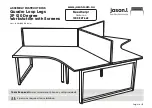
8
5.
Remove the protective sleeve around the screw rod, clean away the antirust grease on the screw rod and
hand wheel with kerosene, fill some lubricants to the contacts between screw rod and hand wheel, and then
resume the protective sleeve.
6.
The larger anvil is put into the hole at the top of screw rod, and then places the level meter onto the larger
anvil. Metallic pads may be put under the bottom of the tester so as to adjust the levelness to be within
0.2/1000.
7.
Insert the micrometer into the hole reserved for it.
8.
Insert the plug in the coder socket (25)
9.
Take out power cable and plug it properly.
Note: As the power cable is three-corded, three-foot power socket is necessary and it should be well
grounded.
Take out the printer and data lines, and plug properly.
Take out the weights and hang them onto the larger lever.
Fig-7 Removing wood wedge of larger lever
Fig-6 Removing wood cushion of the indente
10
Preparation prior to normal operation
1) Prefabrication of specimen: the specimen shall be polished with smooth and flat surface, free from layers of
oxide skins, electroplated layers oil dirt and any defects. In addition, the surface roughness Ra should not be more
than 0.016mm. Its hardness should not be changed due to heating or processing. Also the parallelism should be
guaranteed.
2) The requirements for selection of indenter, fitting of indenter and specimens
A. Selection of indenter (Table 4)
Table 4: Correlation Table of tungsten carbide ball diameters and test forces for Brinell Hardness Test
































